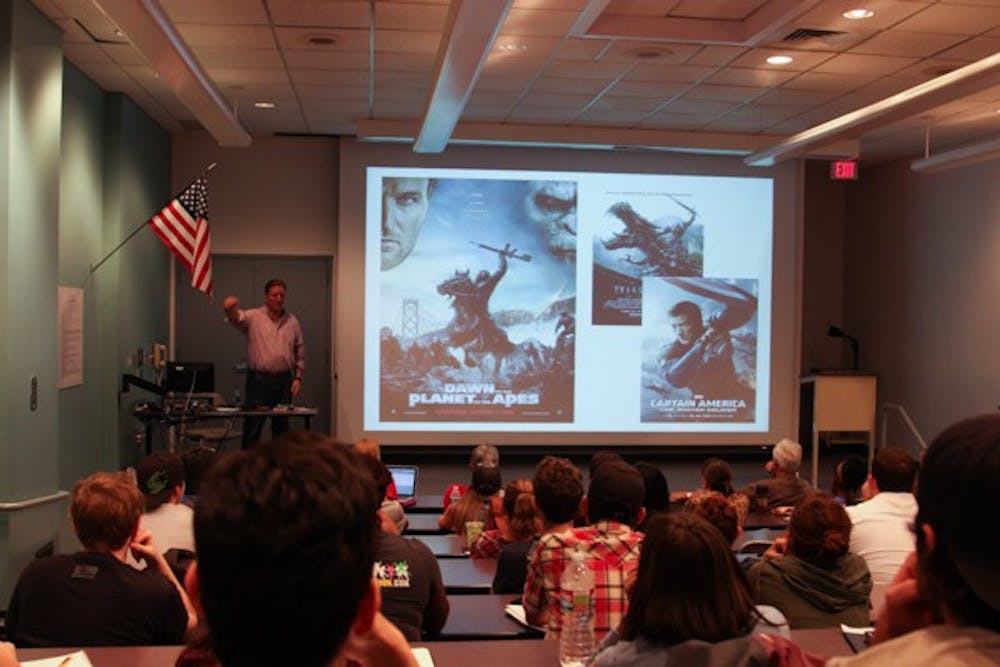 Bunnygraph Entertainment CEO John D. Heinsen shows the similarities between Hollywood movie posters during his presentation on transmedia at the Durham Language and Literature building on Tuesday, Oct. 21st. (Photo by Daniel Kwon)
Bunnygraph Entertainment CEO John D. Heinsen shows the similarities between Hollywood movie posters during his presentation on transmedia at the Durham Language and Literature building on Tuesday, Oct. 21st. (Photo by Daniel Kwon)John Heinsen, the CEO and owner of Bunnygraph Entertainment, has always been passionate about his love for media and the ever-changing technologies.
A group of ASU students gathered Tuesday to hear Heinsen speak on transmedia in the entertainment marketplace and the different trends that are occurring when building a community around a brand.
“We are at a crossroads right now,” said Heinsen. “Technology is evolving, and there are no standards.”
With new platforms of media constantly developing and changing many studios and organizations are missing out on opportunities to maximize their brands. Heinsen stressed the importance of understanding transmedia and the different elements of it.
“Transmedia is really a new medium of content,” said Heinsen. “It’s the convergence of multiple platforms and its collaborations of traditional media, advertising and technology."
With multiple different platforms and all these different elements converging, many companies struggle to successfully create and maintain advance content that will succeed in a multi-platform environment.
Heinsen suggested six steps to follow when when creating advance. The first step is development, or deciding what the story is and who the characters are.
 Bunnygraph Entertainment CEO John D. Heinsen gestures during his presentation on transmedia at the Durham Language and Literature building on Tuesday, October 21st. (Photo by Daniel Kwon)
Bunnygraph Entertainment CEO John D. Heinsen gestures during his presentation on transmedia at the Durham Language and Literature building on Tuesday, October 21st. (Photo by Daniel Kwon)“All those YouTubers and Viners are not real storytellers,” Heinsen said. “The reasons why shows like 'Modern Family' and the 'Big Bang Theory' are so good is because they are like NBA all star-teams. All these writers that 10 years ago would each have their own show, there aren’t shows for them, so networks put them all together. These are the best writing teams.”
The second step in creating advance content in a transmedia ecosystem is to identify the audience. Heinsen said it is importance to know an audience and who content is pursuing so creators can best meet their needs.
The next step in his plan building the "storyworld," or recognizing where the audience lives in the digital world and the best ways to engage the audience.
Film and media studies senior Zach Schwartz said he no longer uses traditional platforms when seeking content.
“I don’t watch TV on my TV anymore,” Heinsen said. “I watch it on my computer and on my phone.”
Distribution is the fourth step, Heinsen said. This is how storytellers successfully distribute a story to engage the audience in an effective way. Heinsen said it's important to market content through several different platforms before, during and post-production of a given story.
The fifth step is production, which is the process of adjusting normal production practices to best capture advanced content. The final step is monetization.
By following these six steps, Heinsen said companies and studios will be able to more effectively develop content in a transmedia ecosystem.
Many students’ eyes were opened when Heinsen talked about the evolving the changing media ecosystem and the importance of embracing transmedia. Sustainability sophomore Annika Andersen said her views on digital media started to change after listening to Heinsen’s speech.
“I really liked him as a speaker,” Andersen said. “It made me reevaluate how I feel as an audience member. I really like that it is moving towards a new model of thought.”
Heinsen said he uses his passion for media to inform and share his view on the ever-changing digital ecosystem.
“When I was in school it was all about understanding the past so you could replicate it and have your own path to success,” Heinsen said. “Now that’s not the case. It’s all about the new collaborations that are making the milestones. Don't let anyone tell you not to collaborate with anyone else.”
Reach the reporter at eaharri4@asu.edu or follow her on Twitter @lissabissa09
Like The State Press on Facebook and follow @statepress on Twitter.




